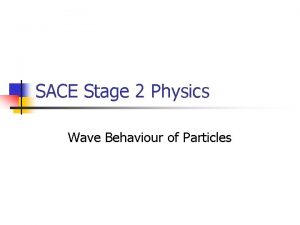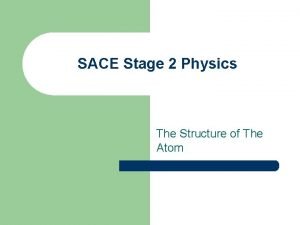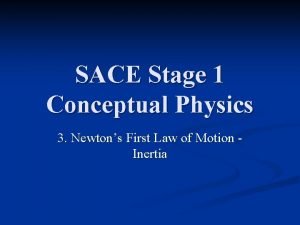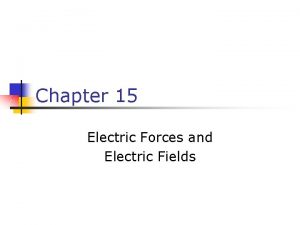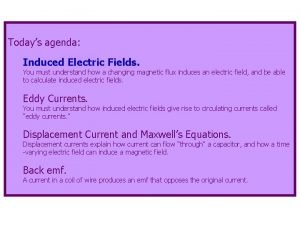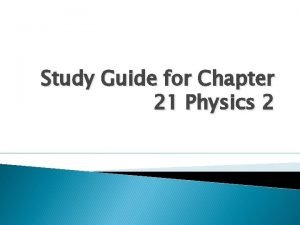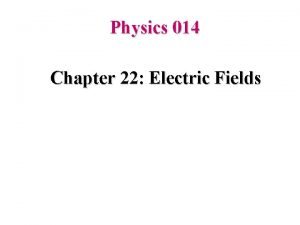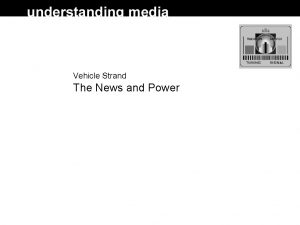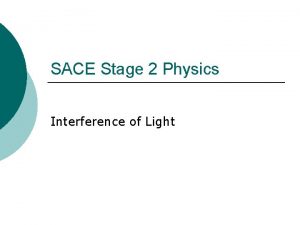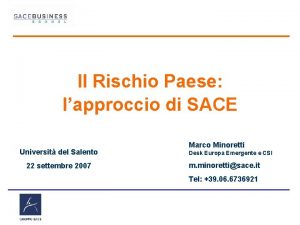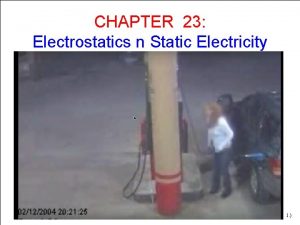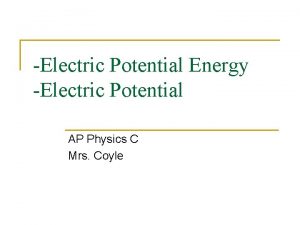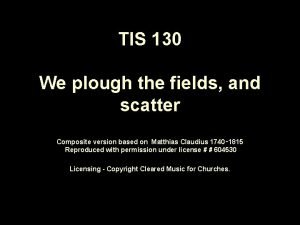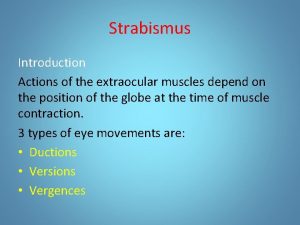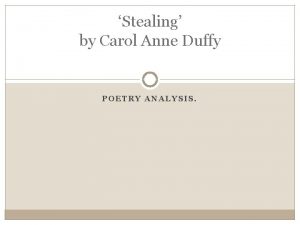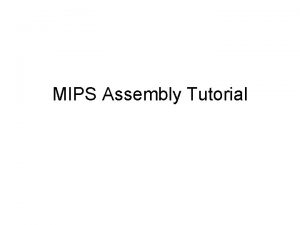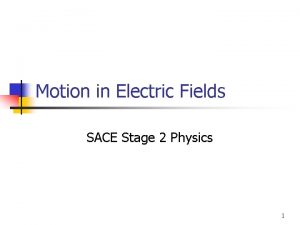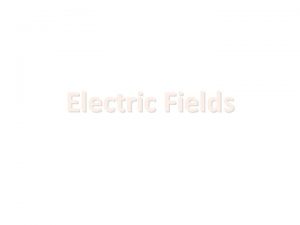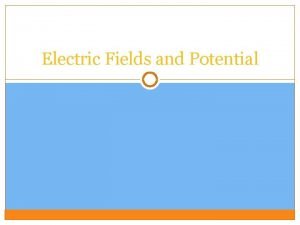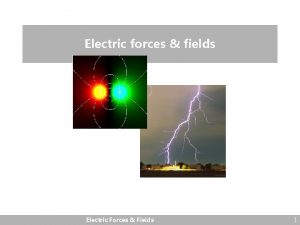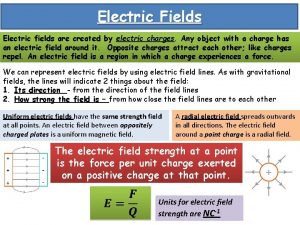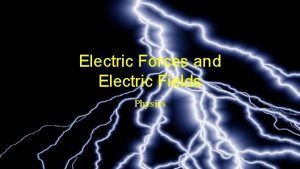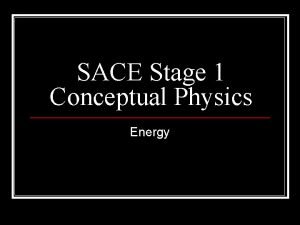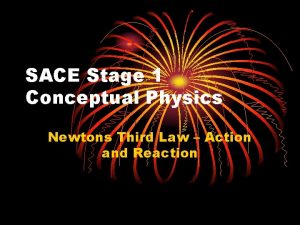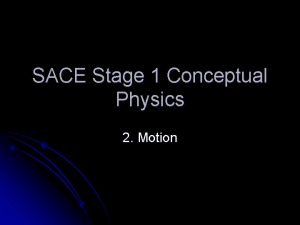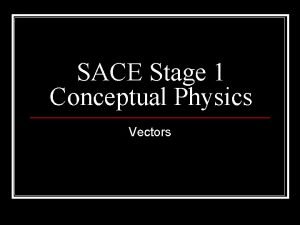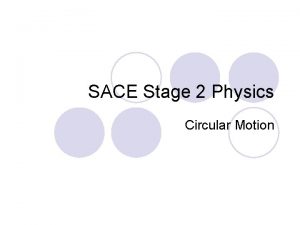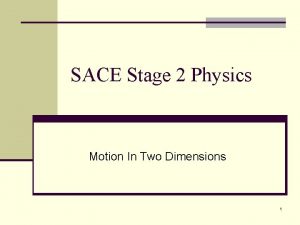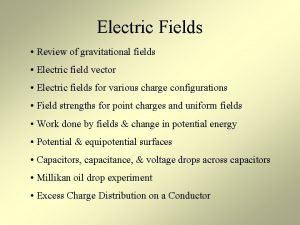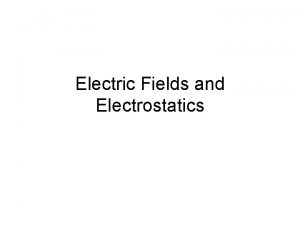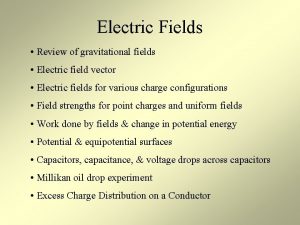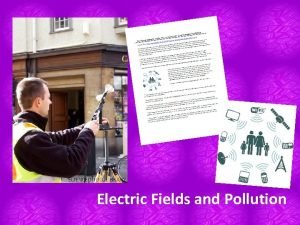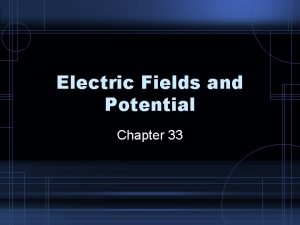SACE Stage 2 Physics Electric Fields 1 Electric

























































- Slides: 57

SACE Stage 2 Physics Electric Fields 1

Electric Fields n Unit of Charge Electric charge (q) is measured in units of Coulomb (C) Definition The coulomb is defined as the amount of charge transferred by an electric current of 1 Ampere in 1 second. 1 coulomb = 1 ampere x 1 second 2

Electric Fields n Unit of Charge Comparison of Charge and Mass of Electrons and Protons The charge on an electron is exactly the same as the charge on a proton. However, a proton has a mass approximately 2000 times the mass of an electron. qe = e (symbol for the charge on an electron) me mp=2000 me qe= -1. 6 x 10 -19 C qp= +1. 6 x 10 -19 C 3

Electric Fields n Size of the Coulomb The Coulomb is a very large unit of charge. Eg, consider the amount of charge contained in the electrons in 1 g of hydrogen atoms. 1 g contains Avogadro's number of particles (6. 02 x 1023) number of electrons (Ne) = 6. 02 x 1023 Total Charge of electrons (qe) = Ne x charge on an electron (e) = (6. 02 x 1023 ) x (- 1. 60 x 10 -19) = - 96320 Coulomb. Similarly the total charge of the protons is + 96320 Coulomb. 4

Electric Fields n Size of the Coulomb Consider the number of electrons which need to be moved to produce a charge of 10 -6 C. Hence to produce this charge it is necessary to shift 6. 3 x 1013 electrons from 1 g of hydrogen (for example). As a fraction, this means that we shift (6. 3 x 1013)/(6. 02 x 1023) 1 x 10 -10 or 10 -8 %, ie, producing a charge of 10 -6 C in the lab would involve moving 0. 00000001 % of the electrons in 1 gram of hydrogen 5

Electric Fields n Size of the Coulomb Hence the Coulomb unit is very large and therefore we use smaller units: eg 1 milli-Coulomb = 10 -3 = 1 m. C 1 micro-Coulomb = 10 -6 = 1 C 1 nano-Coulomb = 10 -9 = 1 n. C 1 pico-Coulomb = 10 -12 = 1 p. C 6

Electric Fields n Conservation of Charge The fundamental concept in the model of electricity used here is the concept of Conservation of Charge In any system the total amount of charge remains constant. 7

Electric Fields n Conservation of Charge Pair production: high energy bundle of electromagnetic radiation (gamma ray photon) interacts with the nucleus of an atom knocking out a pair of subatomic particles, a proton and an electron protons and electrons are produced (created) in equal numbers to conserve charge before = 0 charge after = e+ + e- = 0 heavy nucleus proton 8

Interaction Between Charges n Coulomb’s Law F 1 p. C F 10 C Line joining charges 10 C Newton's Third Law still applies. The size of the two forces is the same, but the directions of the forces exerted by each object on the other are opposite. 9

Interaction Between Charges n Coulomb’s Law NOTE : ONLY ONE FORCE ACTS ON EACH OBJECT, SO THERE IS A NET FORCE ON EACH OBJECT. Only one force acts on this object 10

Interaction Between Charges n Coulomb’s Law v This force causes an acceleration (eg centripetal acceleration) It is found that the force also depends on the charges and their distance apart. eproton FC 11

Interaction Between Charges n Coulomb’s Law Any two point charges have acting on them equal sized, oppositely directed forces acting along the line joining their centres. The magnitude of these equal sized forces is directly proportional to the product of the charges and inversely proportional to the square of their distance apart. The forces are attractive for unlike charges and repulsive for like charges. constant [Constant = 9 x 109 N m 2 C-2 in a vacuum and can be assumed to be the same in air] 12

Interaction Between Charges n Example Consider the repulsive force between the electrons in 1 g of hydrogen atoms placed on either side of the earth. F 1 g of H Earth D = 12700 km F 1 g of H 13

Interaction Between Charges An equivalent mass of 50, 000 kg would be needed to produce the same force! Electric forces are much stronger than gravitational forces. 14

Ratio of Gravitational Forces and Electric forces Can find the ratio between Electric force and Gravitational force by considering an electron and a proton. (hydrogen atom, 1 proton, 1 electron) R electron proton 15

Ratio of Gravitational Forces and Electric forces Fe = Fe : F g since qp = +e or = ratio of force independent of separation of particles. = 2. 3 x 10 -28 r-2 Fg = = 2. 3 x 10 -28 r-2 1. 01 x 1067 r-2 = 2. 3 x 1039 Fe = 2. 3 x 1039 Fg = 1. 01 x 10 -67 r-2 16

Form of Constant in Coulomb's Law F = where is known as the Permittivity constant of free space = 9 x 109 N m 2 C-2 Do not represent as ke, it is incorrect as it has its own meaning. 17

Electric Force due to More than 1 Charge C 4 cm q. C +5 C 3 cm q. A+5 C A 5 cm B q. B +5 C The Charge at C will experience forces due to the charge at A and the charge at B. To find the resultant field we need to add the forces due to A and B as vectors. 18

Electric Force due to More than 1 Charge The Force on C Due to A: F = The Force on C Due to B: F= = 140. 6 N = 250 N Away from A along the line BC and away from B 19

Electric Force due to More than 1 Charge ie. By VECTOR ADDITION: ie adding FA and FC – shown opposite. By Pythagoras’ Theorem FB= 250 N FResultant q FA = 140. 6 N 20

Electric Force due to More than 1 Charge tan q = 60. 6° ie. Fresultant = 286. 8 N at 60. 6° to the line joining A and C. (As shown) 21

Electric Fields The field concept is needed to explain how charges exert "forces at a distance" on other charges. Field model for Electric Charges large force Source Charge +q. T test charge strong field small force +q. T test charge weak field 22

Electric Fields An electric field exists in a region of space if electric charges experience forces in that space. F -q. T F +q. T The direction of the field is the direction of the force on POSITIVE CHARGES 23

Example A Calculate the electric field strength at a point P 10 cm from a point charge of + 10 C. 24

Electric Fields If we use lines to represent these electric fields, then the spacing of the lines represents the size of E and the direction of the lines represents the direction of E. E E 25

Derivation of the Electric Field Strength at a point in an Electric Field Consider a small test charge qt placed a distance r from a source charge qs qt r qs 26

Example A Calculate the electric field strength at a point P 10 cm from a point charge of + 10 C. 27

Example B Calculate the force on an electron placed at point P. (Charge on an electron, qe = 1. 6 x 10 -19 C. ) 28

Example B Calculate the force on an electron placed at point P. (Charge on an electron, qe = 1. 6 x 10 -19 C. ) 29

Example C Calculate the acceleration of the electron. 30

Example C Calculate the acceleration of the electron. 31

Rules For Drawing Electric Field Lines 1. Electric field lines do not cross Incorrect 2. begin on positive charges and end on negative charges NOT 3. The direction of the field is the direction of the force on a positive test charge F +q +q F 32

Rules For Drawing Electric Field Lines Strong field 4. The number of field lines per unit area represents the strength of the field. 5. Field lines cut conductors at 90 o. Weak field F 6. No field exists in a conductor. 33

Electric Fields due to Point Charges - 34

Electric Fields in Nature In household wires 10 -2 In radio waves 10 -1 In the atmosphere 102 In sunlight 103 Under a thundercloud 104 In a lightning bolt 104 In an X-ray tube 106 At the electron in a hydrogen atom 6 x 1011 At the surface of a uranium nucleus 2 x 1021 35

Electric Fields due to more than one charge Consider the electric field at a point P due to two positive charges of magnitude +5 C positioned as shown below. P 4 cm 3 cm q. A = +5 C 5 cm q. B = +5 C At point P there are electric fields due to A and B. Any charge at P will experience forces due to the charge at A and the charge at B. To find the resultant field we need to add the fields due to A and B as vectors. 36

Electric Fields due to more than one charge Electric field due to q. A Electric field due to q. B 37

Electric Fields due to more than one charge Vector Diagram EB Er To calculate the length and direction of the resultant Electric Field, will need to use the cosine rule (if right angled triangle, use Pythagoras) and your trig ratios. EA 38

Electric Field due to point charges of equal magnitude but opposite sign: - 39

Electric Field due to point charges of equal magnitude and the same sign: + 40

An Infinite Conducting Plate The electric field for an infinite conducting plate must be uniform. A positive charge leaving a positively charged surface would be equally repelled from all directions. The positive charge must move at right angles to the surface. A similar charge at a different position on the plate must also have the same force exerted on it from all directions so it too must move away from the plate at right angles. 41

An Infinite Conducting Plate For a positively charged infinite plate: 42

An Infinite Conducting Plate Two Parallel Infinite Conducting Plates Field due to Negative Plate Field due to Positive Plate Net Field here is ZERO! Negative Plate Positive Plate Net Field here is ZERO! Net field outside the plates must be zero as the uniform field from the infinite negative plate means the field strength must be the same everywhere, and the same applies to the positive plate ie. at a given point outside the plates the fields from each plate cancel by the principle of superposition. 43

Electric Fields and Conductors There cannot be a parallel component to the electric field at the surface of a conductor as this would imply that there is a force on the charges on the surface and as they are static charges and that the field is uniform at the surface, therefore parallel component = 0. + _ There is no electric field inside the conducting material. 44

Electric Field Inside a Hollow Conductor No field inside the hollow conductor A Hollow Spherical Uncharged Conductor Placed in the Region Between Two Oppositely Charged Parallel Plates: + _ 45

Electric Fields and Sharp Points: The electric field around a Pear Shaped Object: Stronger field is in the vicinity of the sharpest curvature (at points of maximum curvature). 46

Electric Fields and Sharp Points A test charge is placed at position P as shown below. If the net force at P is zero, then there must be a greater charge on the smaller sphere. Now this corresponds to the fact that if the charged object is pear shaped then considering the position P inside the object, hence net force on a test charge at P will only be zero if there are more charges at the sharper end of the object. P P 47

Corona Discharge At the sharp end of a pair shaped conductor, the build up of charge can be large enough to create an electric field large enough to accelerate ionic particles in the air, which, when accelerating, collide with other particles in the air and they to, become ionised. This charges the air in the vicinity of the sharp end of the conductor to draw away any excess charge. 48

Application: Photocopier and Laser Printers Photocopying Materials, such as selenium, that conduct better in light than the dark are known as photoconductive. If a selenium surface was positively charged in the dark, light will cause electrons to be drawn to it to neutralise the charge only where light was incident. Because selenium is not a good conductor the charge remains on the surface in a static position. 49

The Process of Photocopying Important mechanical part of a photocopier is the cylindrical aluminium drum with a coating of Selenium. Aluminium is a good conductor of electricity and is therefore earthed. All processes occur as the drum rotates. 1. Charging the Drum A highly charged wire (Corona Wire) at 5000 V to 8000 V extends the length of the drum and close to it. As the corona wire is highly charged, the corona effect allows positive charges to ‘jump’ on to the drum. 50

The Process of Photocopying 2. Projecting an image onto the drum. The original image is placed onto a flat glass platten of the photocopier. A strip of bright light is passed over the image and then through a series of mirrors on to the drum. Where there is black on the original image, no light is reflected, were there is white, lot of light is reflected and where there is grey, some light is reflected. Where the light hits the selenium drum, it becomes conductive and draws electrons from the aluminium drum to neutralize it. This leaves an invisible latent image on the drum. 51

The Process of Photocopying 3. Applying toner to the Drum The drum then passes a position where negatively charged toner (a black powder) is dusted onto the drum. The toner consists of fine toner particles (negative) stuck to larger iron particles (positive). There is a magnetic roller (near the main drum) attracts the iron carrier particles containing the toner to its surface. As the positive charge is much larger on the selenium drum than the iron particles, the toner particles are attracted on to the main drum. The toner is the attracted to the charged areas of the selenium only. This leaves an image on the selenium of the original image. 52

The Process of Photocopying 4. Putting the image onto paper using the corona wire. Paper is now passed next to the selenium coated drum. Just before the paper is passed the selenium drum, it passes another positively charged corona wire (the transfer corona) which charges the underside of the paper. This charge is stronger than the charge on the drum so that as the paper passes the selenium drum, the image is transferred onto the paper. 53

The Process of Photocopying 5. Discharging the Paper with a Corona Wire. As soon as the paper has passed the selenium drum it passes another corona wire which is negatively charged to neutralise the paper. 6. Fixing the Image onto the Paper At this stage the paper is carrying toner particles. The paper is then fed between two rollers (fusing rollers) which melts the toner to the paper. The upper roller is a hot roller used to melt the toner and the lower roller is a presure roller so that when the toner has melted the presure causes the toner to melt into the fibre of the paper. 54

The Process of Photocopying The drum is then scraped to removed any excess toner and then exposed to bright light to drain off any residual charge. The next cycle of copying can begin. 55

The Process of Laser Printing The process of laser printing is similar to that of photocopying. Instead of using a strip of white light, a laser beam is focused onto the drum. The corona wire charges the drum, a laser beam is focussed onto it which selectively discharges the drum. The area of the drum is the same as the area of the paper onto which the image will appear. The laser (controlled by a computer) scans the drum (which spins very quickly) and selectively discharges the drum in the spots that will appear white in the final copy. 56

The Process of Laser Printing The toner is applied, as in photocopying, and the whole process from then on is the same as in photocopying. 57
 Sace wave
Sace wave Sace stage 2 physics
Sace stage 2 physics Sace physics
Sace physics Sace stage 2
Sace stage 2 Red fields
Red fields Electric forces and fields concept review
Electric forces and fields concept review Chapter 16: electric forces and fields answers
Chapter 16: electric forces and fields answers Electric fields quiz
Electric fields quiz Chapter 33 electric fields and potential
Chapter 33 electric fields and potential Electric fields
Electric fields Electric fields
Electric fields Field
Field Physics 2 study guide
Physics 2 study guide Electric currents and magnetic fields
Electric currents and magnetic fields Visualizing magnetic field
Visualizing magnetic field Electric field for a disk
Electric field for a disk Sace scaling
Sace scaling Sace cptd management system
Sace cptd management system Plato sace
Plato sace Sace wave
Sace wave Scheda paese sace
Scheda paese sace Sace english literary studies
Sace english literary studies Sace annual report
Sace annual report Sace center
Sace center Export plus sace
Export plus sace 1. denial
1. denial Acting area
Acting area Type of stage
Type of stage Single stage and two stage tender
Single stage and two stage tender What is drama
What is drama Stage left vs stage right
Stage left vs stage right Modern physics vs classical physics
Modern physics vs classical physics University physics with modern physics fifteenth edition
University physics with modern physics fifteenth edition Physics ia ib examples
Physics ia ib examples Chapter 35 electric circuits
Chapter 35 electric circuits Electricity
Electricity Examples of electromagnets
Examples of electromagnets Potential formula
Potential formula Ap physics c electric potential
Ap physics c electric potential Electric potential of dipole
Electric potential of dipole Potential energy of capacitor
Potential energy of capacitor Electric field from electric potential
Electric field from electric potential A suitable electric pump in an electric circuit is a
A suitable electric pump in an electric circuit is a Chapter 21 electric charge and electric field
Chapter 21 electric charge and electric field Chapter 21 electric charge and electric field
Chapter 21 electric charge and electric field Chapter 16 electric charge and electric field
Chapter 16 electric charge and electric field Dc o/d per item charge
Dc o/d per item charge Electric charges and electric forces lesson outline
Electric charges and electric forces lesson outline Norm rule fields
Norm rule fields How many fields in computer science
How many fields in computer science We plough the fields and scatter
We plough the fields and scatter Decreased tactile fremitus
Decreased tactile fremitus Six cardinal fields of gaze
Six cardinal fields of gaze 6 cardinal fields of gaze
6 cardinal fields of gaze Stealing carol ann duffy analysis
Stealing carol ann duffy analysis Slope fields ap calculus
Slope fields ap calculus Rodan and fields tax write offs
Rodan and fields tax write offs Mips code example
Mips code example
